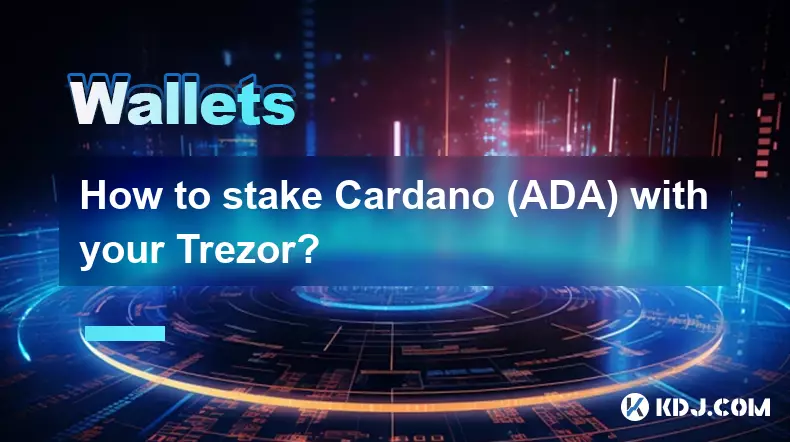-
 bitcoin
bitcoin $115849.501581 USD
-0.20% -
 ethereum
ethereum $4657.446044 USD
-1.30% -
 xrp
xrp $3.094289 USD
-0.74% -
 tether
tether $1.000313 USD
-0.03% -
 solana
solana $243.548889 USD
0.20% -
 bnb
bnb $930.722647 USD
0.20% -
 usd-coin
usd-coin $0.999696 USD
-0.01% -
 dogecoin
dogecoin $0.283551 USD
1.29% -
 tron
tron $0.349632 USD
-0.77% -
 cardano
cardano $0.915982 USD
-1.94% -
 hyperliquid
hyperliquid $54.899464 USD
-0.88% -
 chainlink
chainlink $24.718086 USD
-1.68% -
 ethena-usde
ethena-usde $1.001078 USD
-0.02% -
 sui
sui $3.756062 USD
0.14% -
 stellar
stellar $0.399024 USD
-1.87%
How to stake Cardano (ADA) with your Trezor?
Set up your Trezor to stake ADA securely: update firmware, use Trezor Suite, choose a reliable pool, and delegate without leaving your wallet—your keys stay safe offline.
Sep 14, 2025 at 11:18 am

Setting Up Your Trezor for Cardano Staking
1. Ensure your Trezor device is updated to the latest firmware version. Older firmware may not support Cardano’s network protocols, leading to connectivity or transaction issues. Use the Trezor Suite desktop application to check for updates and install them securely.
2. Install and open the Trezor Suite app, which provides native support for Cardano (ADA). The interface allows you to manage your ADA holdings directly from the hardware wallet while maintaining full control over your private keys.
3. Connect your Trezor via USB and enter your PIN. Once authenticated, Trezor Suite will display your ADA balance if you’ve already received funds on the associated receiving address.
4. Navigate to the Cardano section within Trezor Suite. The platform will show available staking options, including stake pool details, performance metrics, and current delegation rewards.
5. Never enter your recovery phrase on any computer or website. Your Trezor generates and stores private keys offline, ensuring protection against online threats.
Selecting a Reliable Stake Pool
1. Review the list of available stake pools directly in Trezor Suite. Each pool displays key statistics such as saturation level, uptime, margin fees, and historical performance.
2. Choose a pool with consistent block production and reasonable fees. Extremely low fees may indicate a new or unreliable pool, while high saturation can reduce your reward yield due to diminishing returns.
3. Look for pools with a reliability score above 95% and operational transparency. Many reputable pools publish their infrastructure details and audit reports online.
4. Consider smaller, under-saturated pools if you want to support decentralization. Delegating to diverse pools helps maintain network resilience and prevents centralization of stake.
5. Confirm the pool’s ticker and ID before proceeding. Scammers sometimes create fake pools with similar names to deceive users. Double-check the information through independent stake pool directories.
Delegating ADA Through Trezor Suite
1. In the staking section, select “Delegate” and choose your preferred stake pool. A confirmation window will appear, summarizing the delegation transaction, including network fees.
2. Approve the transaction on your Trezor device. You must physically confirm the delegation on the device screen, ensuring no malware can authorize actions without your consent.
3. Wait for the transaction to be confirmed on the Cardano blockchain. This typically takes a few minutes. Once confirmed, your ADA is actively staking, though rewards begin accruing in the next epoch.
4. Delegation does not lock your funds. You retain full control and can spend or transfer your ADA at any time, which automatically undelegates your stake.
5. Monitor your staking activity through Trezor Suite. Rewards are automatically added to your wallet balance at the end of each epoch, usually every five days.
Maintaining Security and Access
1. Regularly back up your Trezor recovery seed in a secure, offline location. This seed is the only way to recover your ADA if the device is lost or damaged.
2. Avoid using third-party wallets or exchanges to stake ADA if you value security. Hardware wallets like Trezor eliminate the risk of private key exposure.
3. Keep your computer and Trezor Suite application free from malware. Use trusted sources for downloads and avoid public networks when managing your wallet.
4. Never share your recovery phrase or allow anyone to scan it. Phishing attempts often mimic legitimate platforms to steal this critical information.
5. Check your wallet balance and staking status periodically. Sudden changes may indicate unauthorized access, though Trezor’s design makes this highly unlikely if proper precautions are followed.
Frequently Asked Questions
Can I stake ADA without sending it to an exchange?Yes. Using Trezor Suite, you can delegate ADA directly from your hardware wallet. The coins remain under your control, and there is no need to transfer them to a third party.
How often are staking rewards distributed?Cardano distributes staking rewards at the end of each epoch, which lasts approximately five days. Rewards are automatically credited to your wallet balance.
What happens if I transfer my ADA after delegation?Transferring ADA automatically removes your delegation. The coins stop earning rewards once moved, and you must re-delegate if you wish to resume staking.
Is there a minimum amount of ADA required to stake?No minimum is enforced by the protocol. Even small amounts of ADA can be staked, though network fees apply for the initial delegation transaction.
Disclaimer:info@kdj.com
The information provided is not trading advice. kdj.com does not assume any responsibility for any investments made based on the information provided in this article. Cryptocurrencies are highly volatile and it is highly recommended that you invest with caution after thorough research!
If you believe that the content used on this website infringes your copyright, please contact us immediately (info@kdj.com) and we will delete it promptly.
- Crypto Presales 2025: Unlocking Millionaire Potential
- 2025-09-14 22:25:12
- Pi Network Price Prediction: Is $0 in 2026 a Real Possibility?
- 2025-09-14 22:50:12
- Remittix, Polkadot, VeChain: Navigating the Crypto Landscape in 2025
- 2025-09-14 22:50:12
- Shiba Inu, Ozak AI, and Presale Gains: Decoding the Crypto Buzz
- 2025-09-14 22:25:12
- MAGACOIN FINANCE: Altcoin Presale Heats Up, Analysts Rank It Among Top Crypto Gems
- 2025-09-14 22:30:12
- Shiba Inu Under Fire: Shibarium Exploit and SHIB Price Rollercoaster
- 2025-09-14 22:30:12
Related knowledge

How to check your crypto portfolio performance in Exodus?
Sep 14,2025 at 08:36am
Accessing Your Portfolio Overview in Exodus1. Launch the Exodus application on your desktop or mobile device and enter your password to unlock your wa...

How to sell crypto from your Exodus wallet?
Sep 13,2025 at 12:01pm
Selling Crypto from Your Exodus WalletExodus is a popular non-custodial wallet that supports a wide range of cryptocurrencies. While it doesn’t allow ...

How to back up your Exodus wallet?
Sep 11,2025 at 04:19pm
Understanding Exodus Wallet Backup Basics1. Exodus is a software wallet that allows users to store, manage, and exchange various cryptocurrencies dire...

How to transfer funds from Binance to your Exodus wallet?
Sep 10,2025 at 10:19pm
Connecting Your Binance Account to Exodus Wallet1. Log in to your Binance account and navigate to the 'Wallet' section under the 'Funds' tab. Select '...

What cryptocurrencies does the Exodus wallet support?
Sep 11,2025 at 03:36pm
Overview of the Exodus WalletExodus is a user-friendly cryptocurrency wallet that supports a wide range of digital assets. Designed for both beginners...

How to export your Exodus transaction history for taxes?
Sep 12,2025 at 04:36pm
Exporting Transaction History from Exodus for Tax Reporting1. Open the Exodus wallet application on your desktop and ensure all transactions are synce...

How to check your crypto portfolio performance in Exodus?
Sep 14,2025 at 08:36am
Accessing Your Portfolio Overview in Exodus1. Launch the Exodus application on your desktop or mobile device and enter your password to unlock your wa...

How to sell crypto from your Exodus wallet?
Sep 13,2025 at 12:01pm
Selling Crypto from Your Exodus WalletExodus is a popular non-custodial wallet that supports a wide range of cryptocurrencies. While it doesn’t allow ...

How to back up your Exodus wallet?
Sep 11,2025 at 04:19pm
Understanding Exodus Wallet Backup Basics1. Exodus is a software wallet that allows users to store, manage, and exchange various cryptocurrencies dire...

How to transfer funds from Binance to your Exodus wallet?
Sep 10,2025 at 10:19pm
Connecting Your Binance Account to Exodus Wallet1. Log in to your Binance account and navigate to the 'Wallet' section under the 'Funds' tab. Select '...

What cryptocurrencies does the Exodus wallet support?
Sep 11,2025 at 03:36pm
Overview of the Exodus WalletExodus is a user-friendly cryptocurrency wallet that supports a wide range of digital assets. Designed for both beginners...

How to export your Exodus transaction history for taxes?
Sep 12,2025 at 04:36pm
Exporting Transaction History from Exodus for Tax Reporting1. Open the Exodus wallet application on your desktop and ensure all transactions are synce...
See all articles










































































